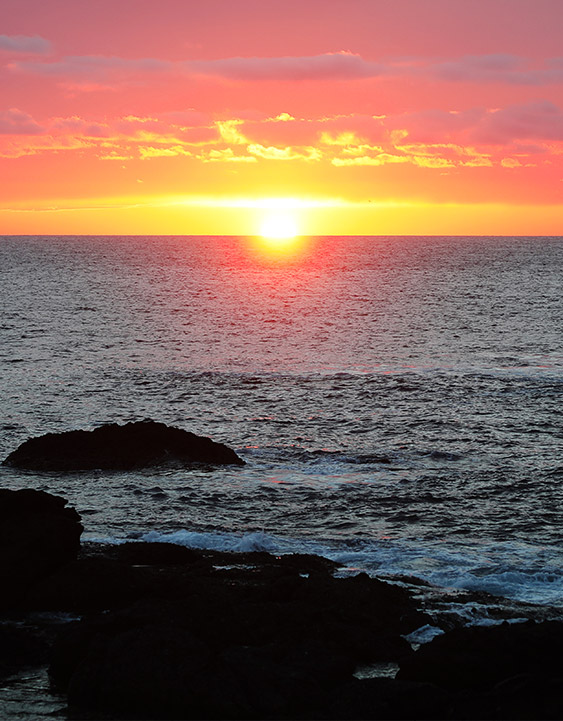A Noh Stage with a Thatched, Hipped Roof and an Air of Dignity
Daizen Shrine
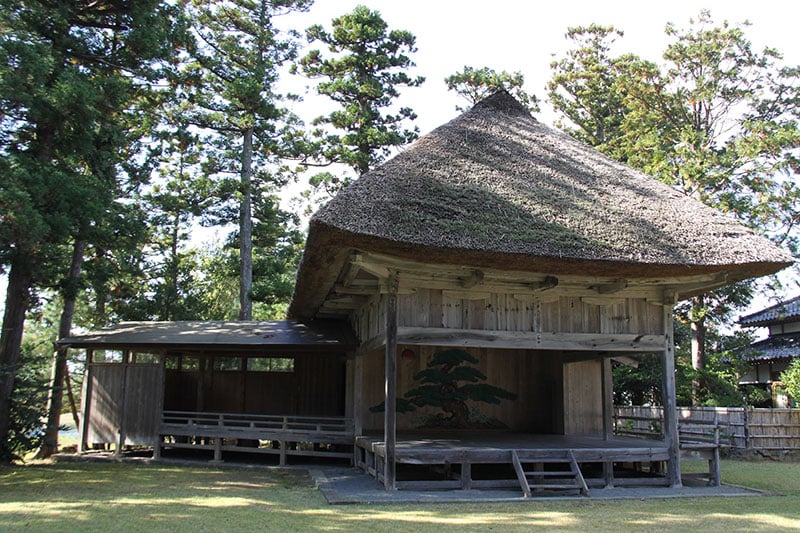
A Noh Stage with a Thatched, Hipped Roof and an Air of Dignity
Daizen Shrine sits in the middle of an open countryside setting. A Noh stage is located on the lawn next to the shrine hall.
The Noh stage was rebuilt in 1846 (2nd year of the Koka Era), and is the oldest existing Noh stage on Sado Island. The thatched roof blends into the surrounding landscape, creating a dignified, elegant atmosphere.
This is a historic Noh stage that is one of "Kuninaka's 4 Noh Stages," which the Katagami Honma clan, the head family of the Sado Hosho School, used as an important base to spread Noh throughout Sado. It has been designated a Tangible Cultural Property by the prefecture.
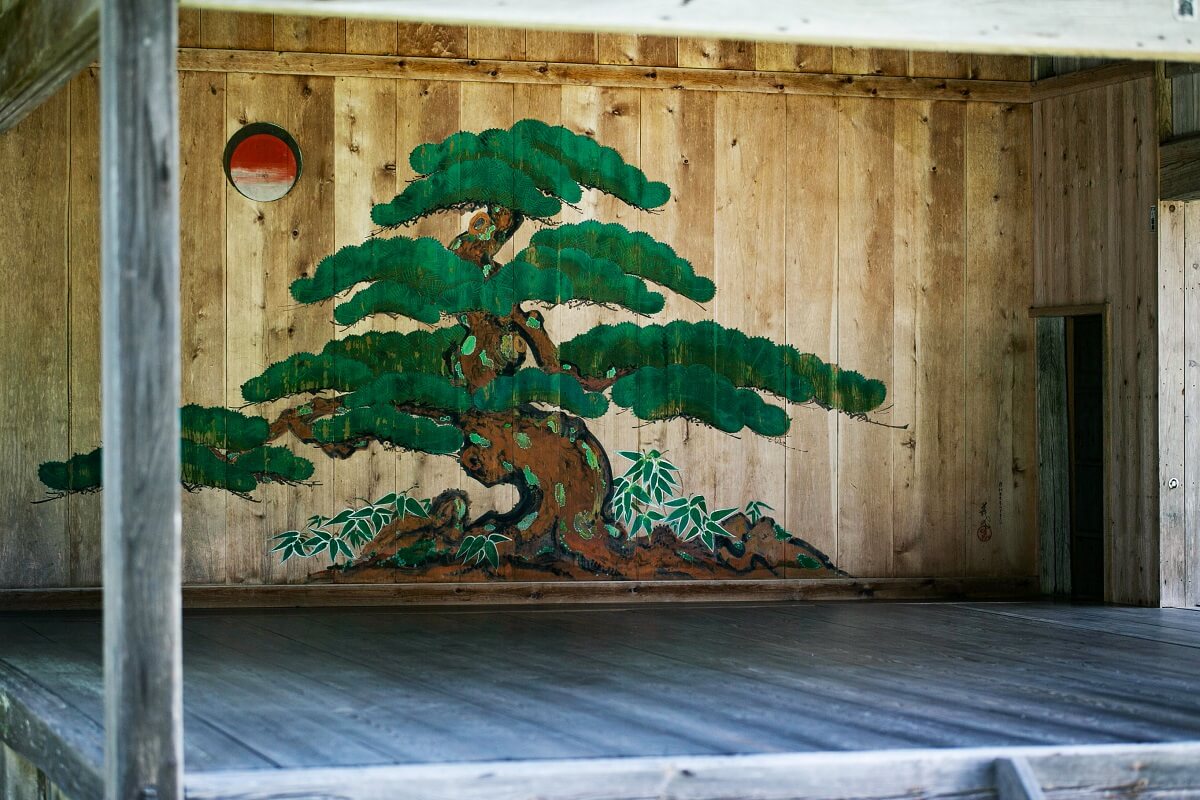
The Only Place to See a Rare Mirror Board Depicting the Sun
Most of Sado Island's Noh stages have doors to keep out the wind and rain, but Daizen Shrine's Noh stage is open to the elements year-round, and the eye is drawn to the unusual mirror board representing the sun above the old pine tree on the stage backdrop.
It is said that this is the only mirror board depicting the sun, and it is thought that it may have religious significance as a visual representation of the appearance of gods and Buddhas.
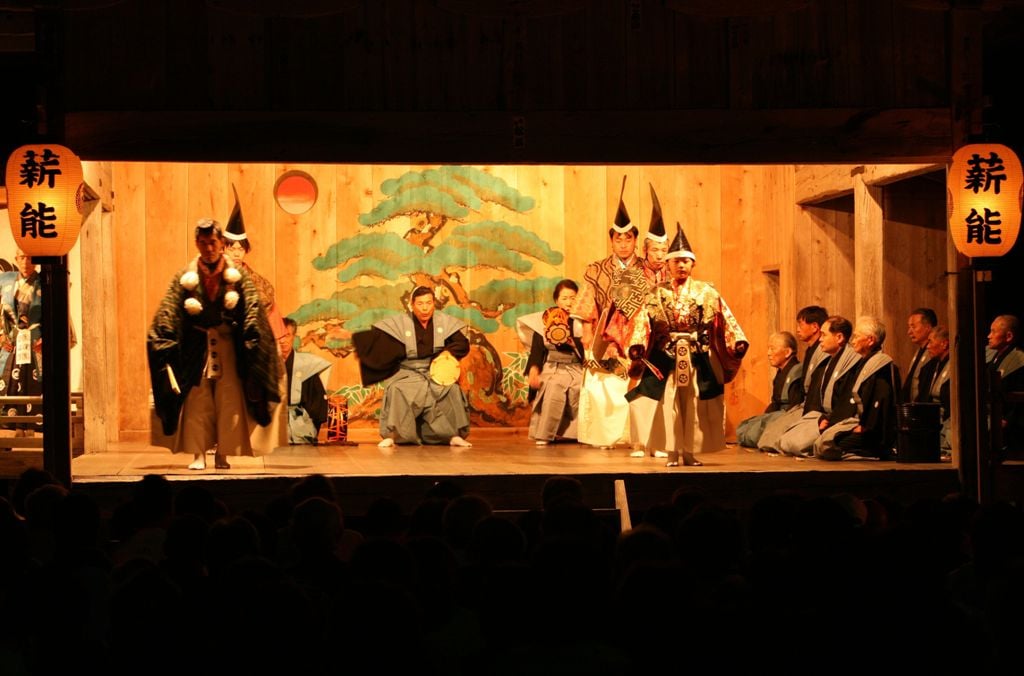
There are Noh Plays Dedicated to the Shrine in April, and Firelight Noh and Sagi Kyogen in June Annually Even Today
Every year on April 18th, a regular Noh performance is dedicated to the gods, and every June there is a Firelight Noh performance of Sado's rare Sagi school of Kyogen.
Many of the people involved in Noh on Sado Island work other jobs while also enjoying performing Noh on stage. Daizen Shrine's regular Noh performances are put on by the Mano Nohgakukai, one of Sado Island's Nohgaku groups, who move audiences in the ethereal world they create from the silence.
Information
- Address
562-1 Takeda,
Sado-shi, Niigata-ken 952-0302
Japan- Tel
+81-259-55-2953
- Traffic Guide
About 30 minutes by car from Ryotsu Port
- Bus Stop
15 minutes walk from "Takedabashi"
- Parking Lot
40 cars
Enjoy Nohgaku through Music
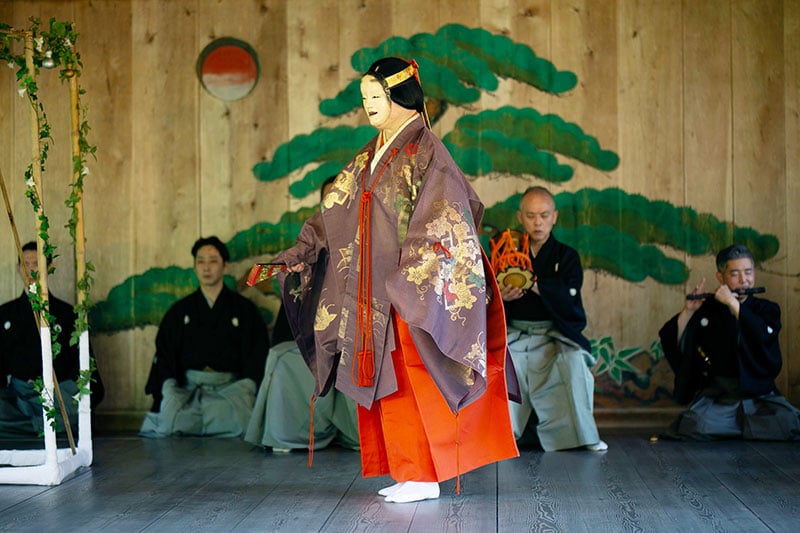
Noh "Hashitomi"
The setting
Kyoto
Story
When a monk makes an offering of offertory flowers, a beautiful woman appears from the shadow of a white bottle gourd flower...
This is a story of devoted love, based on the Tale of Genji.
.jpg)
Kyogen "Sadogitsune"
The setting
Sado Island, Niigata and Kyoto
Story
On the road to Kyoto to pay their land taxes, peasants from Sado and Echigo place bets on whether or not there are foxes on Sado Island.
This is a Kyogen (comedic Noh play) featuring human drama and bargaining over a bribe.
Special Video
Photo Gallery
This is a collection of photos of the landscapes of Sado Island, bursting with seasonal charms, and famous sites related to Nohgaku. We will also introduce some off-screen shots from the filming of "Hashitomi" and "Sadogitsune" at Daizen Shrine.
The Charms of the Seasons in Sado Island
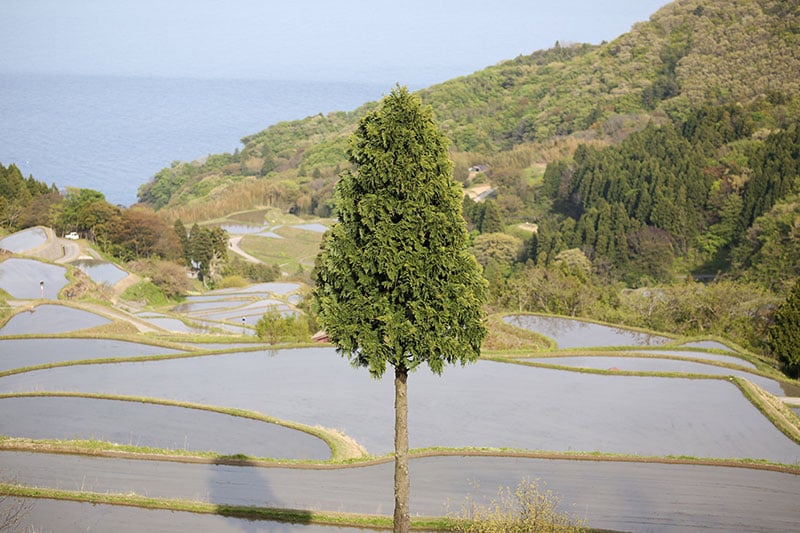
The Terraced Rice Fields of Iwakubi, Nurtured by the Morning Sun
In the spring, don't miss the Iwakubi Shoryu terraced rice fields that stretch from the seaside village of Iwakubi to an altitude of over 350 meters in the mountains!
Built beginning in the Edo period (1603-1868), there are now 460 fields that retain their original shape. The fields take their name "Shoryu (Climbing Dragon)" from their different shapes as they hug the mountain, looking like a dragon climbing up into the heavens.
The effect is especially stunning in early spring, when the morning sun shimmers on the flooded terraced fields.
Iwakubi rice is carefully grown with the blessings of pure spring water from the mountains, the light of the morning sun rising over the sea, and the sea breezes. The people of the village work tirelessly to preserve the terraced rice fields, and in 2011, they were registered as a Globally Important Agricultural Heritage System (GIAHS).
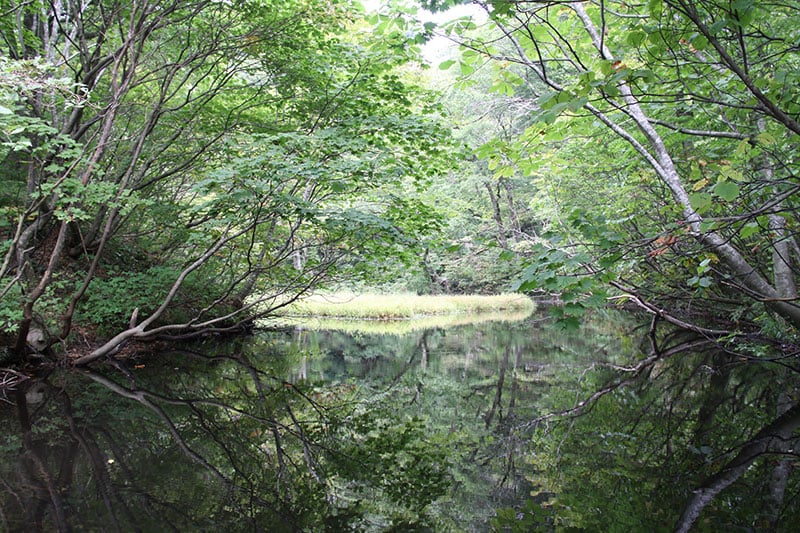
A Secret Paradise where the Power of Nature Lies
A special natural power spot on Sado Island that can only be experienced in the summer!
Otowaike Pond (photo) is located along the Osado Skyline, a 30-km scenic roadway that overlooks all of Sado Island, and together with the surrounding natural forest, as an important natural pond, it has been designated a Natural Monument by the prefecture.
In the midst of Otowaike, on, one of the largest high marshlands in Japan, there is a hole shaped like a heart, which adds to the romantic atmosphere of the place.
The pond gets its name from the legend of Otowa, a beautiful girl who went into the water after being discovered by a great snake, the owner of the pond.
The "Osado Stone Famous Natural Cedar" is a power spot brimming with negative ions that is cool even in summer.
Enjoy the natural cedar trees at an altitude of 900 meters on a circular walking course. The course entrance is accessible by car, and you can get a close up of the uniquely shaped cedars "Ivory Cedar" and "Hagoromo Cedar," as well as giant trees that are over 300 years old.
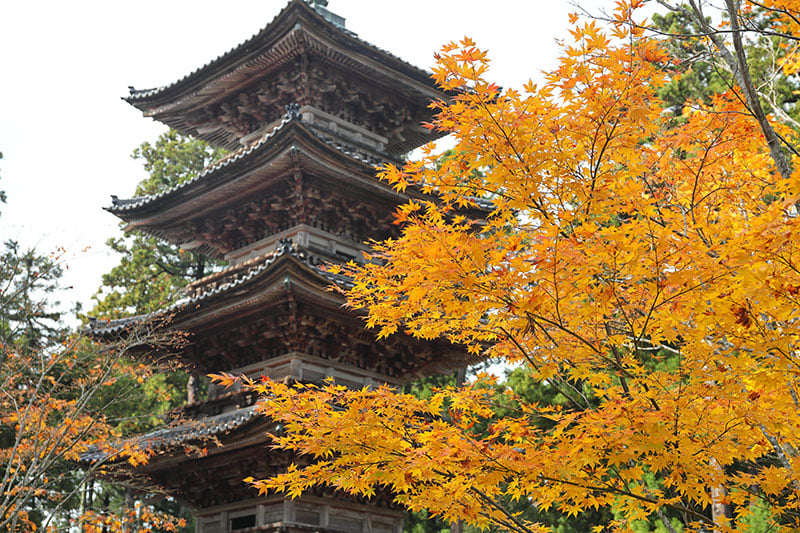
Visit Temples and Shrines Amid the Colors of the Autumn Leaves
The autumn leaves are at their peak on Sado from mid-October to early November. Momijiyama Park is renowned for its autumn leaves.
It is well-known because Zeami, who was exiled to Sado Island, wrote about it in his book "Kintosho."
With this as the staring point, take a tour of the shrines and temples under beautiful autumn leaves in the Kuninaka area at the center of the island, immersing yourself in the romance of Sado's history.
Myosenji Temple (photo) is said to be the successor of Abutsuji Temple, where Abutsubo Nittoku Shonin, a direct disciple of Nichiren who was exiled to Sado, lived. The autumn leaves against the five-story pagoda in the temple grounds, the only one in the prefecture, are magnificent.
Keikuji Temple is part of the Shingon sect, and was named for the legend that Princess Keishi, the first daughter of Emperor Juntoku, spent her days there.
When the leaves change color in autumn, climbing the stairs over the fallen leaves is a charming experience.
Seisuiji is said to have been built as an imitation of Kiyomizudera Temple in Kyoto. On the stone walk from the Niomon gate to the Guzeden, reminiscent of the Kiyomizudera stage, with a row of large cedar trees soaring high into the sky, the beauty of the old temple is glorified.
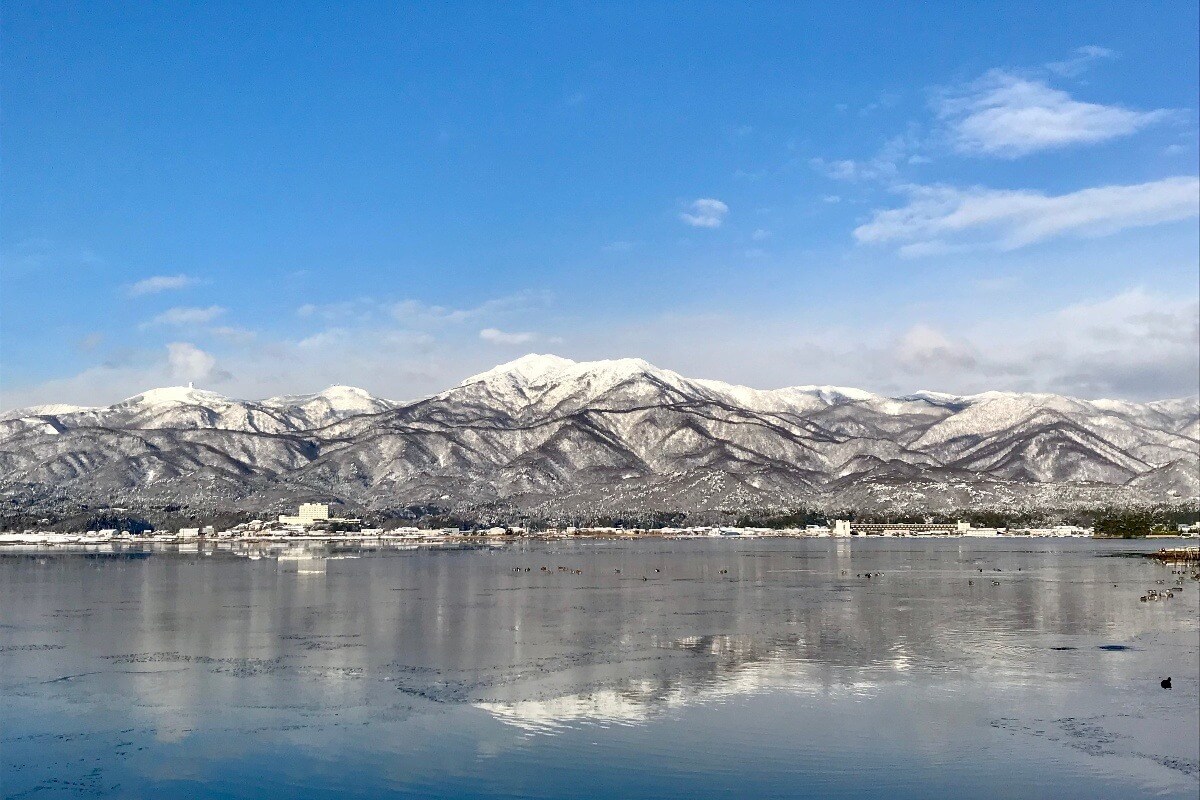
Relax in a Hot Spring Amid the Winter Scenery
Hot springs are one of Sado's winter charms. Not surprisingly, there are many hot springs scattered throughout the island, with many offering spectacular views of the Sea of Japan.
We will introduce the hot spring inns of each area where you can relax in a hot bath while enjoying the stunning winter views, such as the waves of the Sea of Japan, powerful enough to crush rocks, and the snow-capped mountains straight out of a landscape painting.
Aikawa Onsen's Sado Resort Hotel Azuma is said to be "the inn closest to the setting sun" because it is located the farthest west in Sado's northern mountains.
Yawata Onsen's International Sado Kanko Hotel Yawata-kan is a hotel overlooking Mano Bay and the Sado Mountains, where you can enjoy an elegant open-air bath overlooking a pine forest garden.
Kamoko Onsen's Lakeside Inn Yoshidaya is a storied inn that dates back to the Ansei period of the Edo era. The rooftop open-air bath with free-flowing water offers magnificent views of the Sado Mountains, the Sea of Japan, and Lake Kamo.

